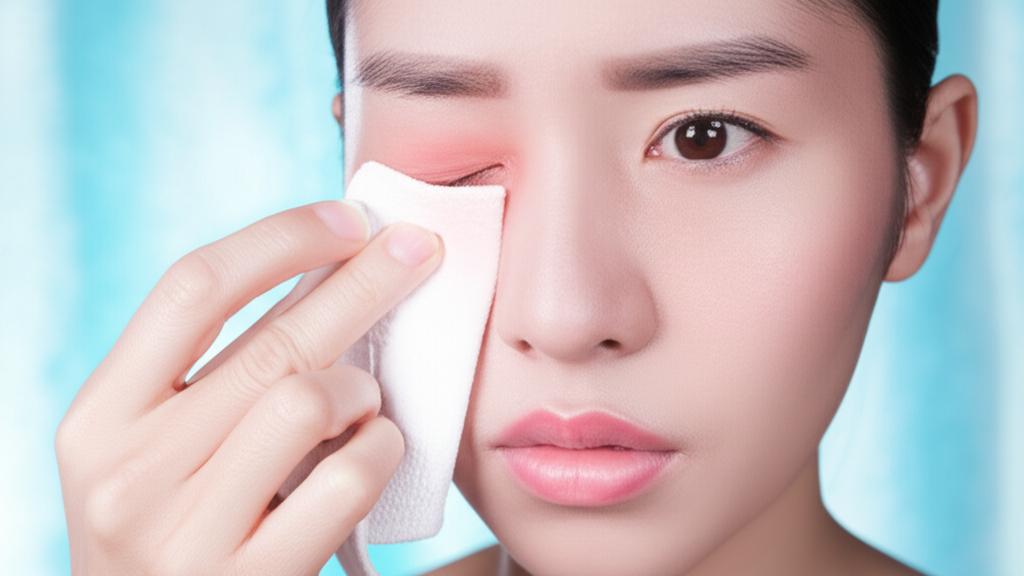You know those mornings? You wake up, and something just feels… off. Your eyelids are heavy, maybe a little puffy, and there’s this nagging itch you just can’t seem to satisfy. You glance in the mirror, and sure enough, they’re red and perhaps even a bit scaly. It’s frustrating, uncomfortable, and honestly, a little alarming. If this sounds familiar, you might be dealing with something called eyelid dermatitis.
So, What Exactly is Eyelid Dermatitis?
In simple terms, eyelid dermatitis (some folks also call it eyelid eczema, periocular dermatitis, or periorbital dermatitis) is a type of contact dermatitis. Think of it like this: the very delicate skin on your eyelids has touched something – a substance or even a physical trigger – and it’s not happy about it. This “contact” leads to a reaction.
We generally see two main types:
- Irritant contact dermatitis: This is the more common one, making up about 80% of contact dermatitis cases I see. It happens when something directly irritates that sensitive eyelid skin.
- Allergic contact dermatitis: This is when your immune system decides to react to a substance it considers an allergen, even if you’ve used that substance before without any issues. Tricky, right?
This kind of eyelid trouble can start slowly or hit you suddenly, usually beginning with redness and that undeniable itch. With treatment, if it’s irritant dermatitis, you might feel better in a day or two. Allergic reactions can take a couple more days to improve. And while contact dermatitis itself is very common – about 15% to 20% of people experience some form of it – it’s not contagious, so you can’t spread it. It’s also not something you inherit from your parents, though a predisposition to sensitive skin or conditions like asthma (which can be risk factors) might run in families.
What Does Eyelid Dermatitis Look and Feel Like?
When your eyelids are protesting, they have a few ways of letting you know. You might notice:
- A red rash that just appears on one or both eyelids.
- A bothersome stinging or burning sensation.
- Skin that looks scaly or flaky.
- Some swelling, making your eyelids feel puffy or heavy.
- It can even be painful for some people.
- And oh, that persistent itching! It can be quite intense.
- Sometimes, tiny blisters might even pop up.
It’s a pretty uncomfortable collection of symptoms, I know. While eyelid dermatitis affects the skin of your eyelids, it doesn’t usually harm the eye itself. However, all that rubbing and scratching because of the itch can certainly make your eye red and sore. And no, it’s not a sign of skin cancer; it’s a temporary, treatable inflammation.
Uncovering the Triggers: What Causes Eyelid Dermatitis?
Figuring out the “why” behind eyelid dermatitis can sometimes feel like a bit of detective work.
For irritant contact dermatitis, the culprits can be:
- Physical triggers: Think extremes like intense heat or cold, very high humidity, or even just repeatedly rubbing or scratching your eyelids. Sometimes, even frequently washing your hands with hot water and harsh soap can transfer irritants if you then touch your eyes.
- Irritating substances: This list is long! It could be dust, cosmetics (like mascara, eyeliner, eye shadow, or even sunscreen), soaps, detergents, bleach, or other chemicals like chlorine. Some metals, scratchy wool, or even certain plants (like peppers or poinsettias if you touch them and then your eyes) can cause a direct irritation.
Then there’s allergic contact dermatitis. This is your body’s immune system overreacting. The tricky part is you might use a product for ages and then, seemingly out of nowhere, a reaction occurs, usually a day or two after exposure. Common triggers include:
- Cosmetics are a big one here too, but also moisturizers, cleansers, aftershave, or eye creams.
- Topical antibiotics (creams or ointments applied to the skin).
- Sunblock.
- False eyelashes (or the adhesives used) or even residues from false nails if you touch your eyes.
- Jewelry, especially pieces containing nickel or gold, if particles transfer to the eyelids.
- Eye drops or contact lens solution.
- Fragrances and essential oils.
- Your glasses frames (some materials or coatings).
- Metals in tools like tweezers or eyelash curlers.
- Latex (found in things like swimming goggles).
- Hair dye.
- Environmental allergens like dust mites, pollen, or the oils from poison ivy, oak, or sumac.
Anyone can get eyelid dermatitis, but you might be more vulnerable if you have sensitive skin, asthma, a history of hay fever, or atopic eczema. A generally weaker skin barrier also makes you more susceptible. Interestingly, what you eat or drink doesn’t usually cause or worsen contact dermatitis.
How Do We Diagnose Eyelid Dermatitis?
So, you come into the clinic, and your eyelids are clearly unhappy. My first step is to have a good look and listen to your story. Those classic signs – red, scaly, swollen eyelids – combined with you telling me they’re itchy, stinging, or burning, often point us strongly towards eyelid dermatitis.
If we suspect an allergy is at play and the trigger isn’t obvious, I might talk to you about a patch test. This is a test where we apply tiny amounts of common allergens to small patches on your skin, usually on your back. We check for reactions after a couple of days. It can be really helpful in identifying specific allergic triggers.
Often, as your family doctor, I can diagnose and help you manage eyelid dermatitis. But sometimes, especially if it’s a tricky case or we need more specialized testing, I might refer you to a dermatologist (a skin specialist) or an allergist (an allergy specialist).
Finding Relief: How We Treat Eyelid Dermatitis
The good news is we can definitely treat eyelid dermatitis and get you feeling more comfortable. Our main goals are to calm that inflammation and, importantly, stop the itch! Treatment often involves:
- Topical Corticosteroids: These are creams or ointments, like hydrocortisone, that you apply directly to the affected skin. They work by reducing redness, swelling, and itching. We’ll always use the mildest effective one for the shortest time needed, especially on delicate eyelid skin.
- Oral Corticosteroids: If the dermatitis is quite severe or widespread, we might consider steroid pills taken by mouth for a short course.
- Calcineurin Inhibitors: These are prescription non-steroid creams or ointments (like pimecrolimus or tacrolimus) that also help calm down the immune response in the skin and can be a good option, particularly for maintenance or if steroids aren’t suitable.
A really important tip: while your eyelids are flared up, it’s best to avoid all eye makeup. I know that can be frustrating, but it truly gives your skin the best chance to heal. And please, resist the temptation to try various at-home remedies without chatting with a healthcare provider first. Some things can actually make eyelid skin angrier!
Living With and Preventing Eyelid Dermatitis
The outlook for eyelid dermatitis is generally good. We can usually get it to clear up. But – and this is a key ‘but’ – it can come back, especially if you re-encounter your trigger. That’s why trying to identify what caused it is so crucial.
You should be able to carry on with your normal daily activities, like work or school. It’s certainly annoying, but it shouldn’t completely stop you. If it’s so uncomfortable that it’s interfering with your life or sleep, please make sure to tell your doctor. And don’t worry, eyelid dermatitis on your eyelids won’t spread to other parts of your skin, though the trigger itself could cause issues elsewhere.
Can you prevent it? Yes, often you can, especially if you know your trigger. Avoiding that specific substance or situation is number one. Beyond that:
- Choose skincare and makeup products made for sensitive skin. Look for labels like ‘hypoallergenic’ or ‘fragrance-free.’
- If you’re going to be around things like extreme cold, high winds, or lots of dust, protective glasses can be a good shield.
- Do your best not to scratch or rub your eyelids. I know, it’s easier said than done when they’re itchy! A cool compress can sometimes help.
- Always touch your eyelids with clean hands.
Some patients ask if diet can help. Unfortunately, there aren’t specific foods or drinks that prevent eyelid dermatitis, nor are there medications to reduce your overall risk, aside from managing underlying conditions that might predispose you.
See your healthcare provider as soon as you notice symptoms. The sooner we start treatment, the quicker you’ll feel better. You should head to the emergency department if your eyelids swell so much you can’t see, or for any other serious medical emergency.
Key Things to Remember About Eyelid Dermatitis
Alright, that was a lot of information! Here are the main points I hope you’ll take away:
- Eyelid dermatitis is an itchy, red, and often swollen rash on your eyelids caused by direct contact with an irritant or an allergen.
- It’s quite common and can be triggered by a wide range of things, from makeup and skincare products to dust or even extreme weather.
- We have effective treatments, usually topical creams or ointments, to calm the inflammation and relieve symptoms.
- Identifying and then avoiding your specific trigger is the most important step in preventing eyelid dermatitis from coming back.
- Don’t hesitate to see your doctor if your eyelids are red, itchy, or swollen – we’re here to help you figure it out and find relief.


